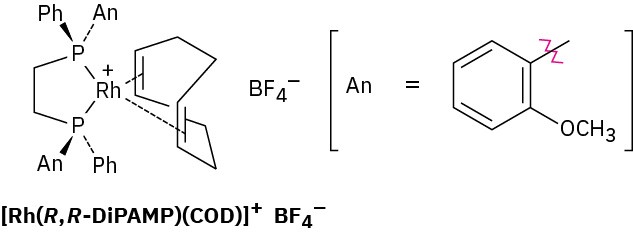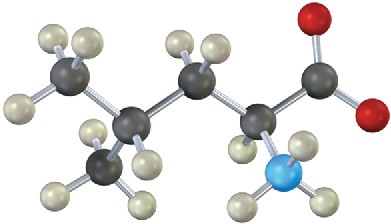26.3 Synthesis of Amino Acids
α-Amino acids can be synthesized in the laboratory using some of the reactions discussed in previous chapters. One of the oldest methods of α-amino acid synthesis begins with α bromination of a carboxylic acid by treatment with Br2 and PBr3 (the Hell–Volhard– Zelinskii reaction; Section 22.4). SN2 substitution of the α-bromo acid with ammonia then yields an α-amino acid.

Problem 26-5
Show how you could prepare the following α-amino acids from the appropriate carboxylic acids:
(a) Phenylalanine (b)
Valine
The Amidomalonate Synthesis
A more general method for preparation of α-amino acids is the amidomalonate synthesis, a straightforward extension of the malonic ester synthesis (Section 22.7). The reaction begins with the conversion of diethyl acetamidomalonate into an enolate ion by treatment with base, followed by SN2 alkylation with a primary alkyl halide. Hydrolysis of both the amide protecting group and the esters occurs when the alkylated product is warmed with aqueous acid, and decarboxylation then takes place to yield an α-amino acid. For example, aspartic acid can be prepared from ethyl bromoacetate, BrCH2CO2Et:

Problem 26-6
What alkyl halides would you use to prepare the following α-amino acids by the amidomalonate method?
(a) Leucine (b) Histidine (c)
Tryptophan (d) Methionine
Reductive Amination of α-Keto Acids
Yet another method for the synthesis of α-amino acids is by reductive amination of an α– keto acid with ammonia and a reducing agent. Alanine, for instance, is prepared by treatment of pyruvic acid with ammonia in the presence of NaBH4. As described in Section 24.6, the reaction proceeds through formation of an intermediate imine which is then reduced.

Enantioselective Synthesis
The synthesis of an α-amino acid from an achiral precursor by any of the methods just described yields a racemic mixture, with equal amounts of S and R enantiomers. To use an amino acid in the laboratory synthesis of a naturally occurring protein, however, the pure S enantiomer must be obtained.
Two methods are used in practice to obtain enantiomerically pure amino acids. One way requires resolving the racemic mixture into its pure enantiomers (Section 5.8). A more direct approach, however, is to use an enantioselective synthesis to prepare only the desired S enantiomer directly. As discussed in the Chapter 19 Chemistry Matters, the idea behind enantioselective synthesis is to find a chiral reaction catalyst that will temporarily hold a substrate molecule in an unsymmetrical, chiral environment. While in that chiral environment, the substrate may be more open to reaction on one side than on another, leading to an excess of one enantiomeric product.
William Knowles at the Monsanto Company discovered in 1968 that α-amino acids can be prepared enantioselectively by hydrogenation of a Z enamido acid with a chiral
hydrogenation catalyst. (S)-Phenylalanine, for instance, is prepared at 98.7% purity, contaminated by only 1.3% of the (R) enantiomer, when using a chiral rhodium catalyst. For this discovery, Knowles shared the 2001 Nobel Prize in Chemistry.

The most effective catalysts for enantioselective amino acid synthesis are coordination complexes of rhodium(I) with 1,5-cyclooctadiene (COD) and a chiral diphosphine such as (R,R)-1,2-bis(o-anisylphenylphosphino)ethane, the so-called DiPAMP ligand. This complex owes its chirality to the presence of trisubstituted phosphorus atoms (Section 5.10).

Problem 26-7
Show how you could prepare the following amino acid enantioselectively:


